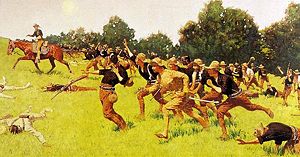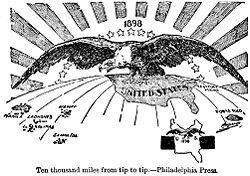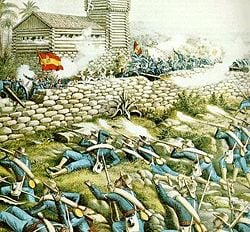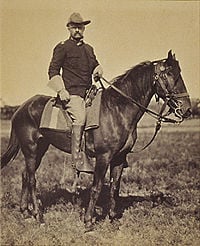| Spanish-American War | |||||||||
|---|---|---|---|---|---|---|---|---|---|
 Charge of the Rough Riders at San Juan Hill by Frederic Remington | |||||||||
| |||||||||
| Combatants | |||||||||
| Commanders | |||||||||
20px William R. Shafter 20px George Dewey |
22px Pascual Cervera | ||||||||
| Casualties | |||||||||
| 3,289 U.S. dead (only 332 from combat); considerably higher although undetermined Cuban and Filipino casualties | Unknown | ||||||||
The Spanish-American War was a conflict between the Kingdom of Spain and the United States of America that took place from April to August 1898. The war ended in victory for the United States and signaled the end of the Spanish empire in the Caribbean and Pacific. Only 113 days after the outbreak of war, the Treaty of Paris, which ended the conflict, gave the United States control over the former Spanish colonies of Puerto Rico, the Philippines, and Guam, and control over the process of independence of Cuba, which was completed in 1902.
Background
Following four centuries of colonization of the Western Hemisphere, by the late nineteenth century Spain was left with only a few scattered possessions in the Pacific Ocean, Africa, and the West Indies. Much of the Spanish Empire had already gained its independence and a number of the areas still under Spanish control were clamoring to do so. Guerrilla forces were operating in the Philippines, and had been present in Cuba since before the 1868-1878 Ten Years' War. The Spanish government did not have the financial resources or the personnel to deal with these revolts and resorted to forcibly emptying the countryside and the filling of the cities with concentration camps (in Cuba) to separate the rebels from their rural support bases. Many hundreds of thousands of Cubans died of starvation and disease in these circumstances—200,000 alone in the more peaceful western Cuba. The Spaniards also carried out many executions of suspected rebels and harshly treated suspected sympathizers. The Cuban War of Independence saw both Cuban rebels and Spanish troops burning and destroying infrastructure, crops, tools, livestock, and anything else that might aid the enemy. By 1897, the rebels had mostly defeated the Spanish. They were firmly in control of the eastern countryside and the Spanish could only leave urban centers in columns of considerable strength. Public opinion in Cuba favored American intervention. Fueled by reports of inhumanity of the Spanish, a majority of Americans became convinced that an intervention was becoming necessary.
Sinking of the USS Maine
On February 15, 1898, an explosion sank the American battleship USS Maine in Havana harbor with a loss of 266 men. Evidence as to the cause of the explosion was inconclusive and contradictory. It may have been an accident, or caused by a Spanish or Cuban mine.
William Randolph Hearst's newspaper in New York, in what became known as yellow journalism, sensationalized the atrocities committed in Cuba. The newspaper included a fake telegram from the Spanish about the sinking of the U.S.S. Maine, embarrassing the U.S. and infuriating the Spanish. Joseph Pulitzer was also a key figure in publicizing the war in New York City. His newspapers, too, exaggerated news of the atrocities to sway popular opinion in favor of intervention. Although Hearst and Pulitzer published inflammatory articles in New York City, major papers elsewhere remained cautious. Americans remained unsure of the cause; most blamed the Spanish for not controlling their harbor.
There were, however, very real pressures pushing toward war within Cuba. Faced with defeat, a lack of money, and resources to continue fighting Spanish occupation, Cuban revolutionary and future president Tomás Estrada Palma, then head of the Cuban Revolutionary Junta, offered $150 million to purchase Cuba's independence, but Spain refused, as the money did not exist. The Cubans then deftly negotiated and propagandized their cause in the United States Congress.
Humanitarian interests dominated American opinion. President William McKinley and House Speaker Thomas Reed worked hard to calm the mood, as did many Republicans, but the pressure from Democrats across the country steadily increased.

Spain could not back down without creating a crisis at home. On the verge of civil war, Spain felt that to surrender to American demands would be politically dangerous. To fight a war against the United States was deemed more acceptable to the Spanish government, even though it expected to lose. That would allow the difficult issue of Cuba to be shed without civil war at home. The U.S. government had considered purchase of Cuba over the years, but had always decided against making an offer. No major American modern leader supported annexing the island because none thought Cuba could be assimilated into the American political system. Much of the island's export business and high technology was already in American hands, and most of Cuba's trade was with the United States. Thus there was no economic need for acquisition of the island, and no major business interests proposed acquisition. Senator John M. Thurston argued that a war would bring more government spending so that, "War with Spain would increase the business and earnings of every American railroad, it would increase the output of every American factory, it would stimulate every branch of industry and domestic commerce." However, most businessmen opposed war and supported McKinley, according to historians' analysis of the business press and statements by business leaders across the country.
The United States Navy had recently grown considerably and been reorganized, but it was still untested, and Navy leaders hoped war would help it prove itself. To this end, the U.S. Navy drew up contingency plans for attacking the Spanish in the Philippines over a year before hostilities broke out.
In Spain, the government was not entirely averse to war. The United States was an unproven power, while the Spanish Navy, however decrepit, had a glorious history, and it was thought it could be a match for its U.S. counterpart. The De Lôme Letter was an example of the doubts of Spain as to whether the United States was powerful enough to defeat them. There was also a widely held notion among Spain's aristocratic leaders that the United States' ethnically mixed army and navy could not endure the pressure of war.
Declaration of war
The main reason for the American declaration of war was Spain's inability to guarantee peace and stability in Cuba. The explosion of the Maine did not cause the war, but it focused American attention on Cuba; the call was for an immediate resolution to the Cuban situation. Spanish minister Práxedes Mateo Sagasta attempted to compromise with an offer to withdraw unpopular officials from Cuba, and yet another proposal for Cuba's autonomy sometime in the future.
The decisive event was probably the speech of Republican Senator Redfield Proctor in mid-March, thoroughly and calmly analyzing the situation and concluding war was the only answer. The business and religious communities, which had opposed war, now switched sides, leaving McKinley and Reed almost alone. Thus, on April 11, McKinley asked Congress for authority to send American troops to Cuba for the purpose of ending the civil war there. On April 19, Congress passed joint resolutions proclaiming Cuba "free and independent" and disclaiming any intentions in Cuba, demanded Spanish withdrawal, and authorized the President to use as much military force as he thought necessary to help Cuban patriots gain freedom from Spain. (This was adopted by Congress from Senator Henry Teller of Colorado as the Teller Amendment, which passed unanimously.) In response, Spain broke off diplomatic relations with the United States. On April 25, Congress declared that a state of war between the United States and Spain had existed since April 21 (later changed to April 20).
Theaters of operation
The Philippines
The first battle was in the sea near the Philippines where, on May 1, 1898, Commodore George Dewey, commanding the United States Pacific fleet, in a matter of hours, defeated the Spanish squadron, under Admiral Patricio Montojo y Pasarón, without sustaining a casualty, at the Battle of Manila Bay. The success of the Pacific Fleet was due to the Spanish Navy being trapped in the bay.
Meanwhile, Dewey allowed Emilio Aguinaldo to return to the Philippines. Aguinaldo's forces attacked the Spanish on land, successfully defeating them and ended with the Battle of Manila (July 25, 1898-August 13, 1898) where the Spanish surrendered Manila, but the U.S. Army made a deal to protect them from Filipino persecution.
Cuba
Theodore Roosevelt actively encouraged intervention in Cuba and, while assistant secretary of the Navy, placed the Navy on a war-time footing. He ordered Dewey and the Pacific fleet to the Philippines and he worked with Leonard Wood in convincing the Army to raise an all-volunteer regiment, the 1st U.S. Volunteer Cavalry. Wood was given command of the regiment that became quickly known as the "Rough Riders."
The first action in Cuba was the establishing of a base at Guantánamo Bay on June 10, by the United States Marine Corps.
Spanish Admiral Cervera, who had arrived from Spain, held up his naval forces in Santiago harbor where they would be protected from sea attack. Assistant Naval Constructor Richmond Pearson Hobson was soon ordered by Admiral Sampson to sink the collier Merrimac in the harbor to bottle up the fleet. The mission was a failure and Hobson and his crew were captured. They were exchanged on July 6, and Hobson became a national hero; receiving the Medal of Honor in 1933, and later becoming a Congressman.
Ground operations in Cuba
The Americans planned to capture the city of Santiago in order to destroy Linares Army and Cervera's fleet, which they must to pass through concentrated Spanish defenses in San Juan Hills and a small town in El Caney. The Americans forces would be aided in Cuba by the pro-independence rebels led by General Calixto García.
On June 22, and June 24, the U.S. V Corps under General William R. Shafter landed at Daiquiri and Siboney East of Santiago and established the American base of operations, unopposed by the Spaniards, who had retreated under assault by Cuban land forces. An advance guard of U.S. forces under former Confederate General Joseph Wheeler ignored Cuban scouting parties and ordered his forces to proceed with caution. They caught up with and engaged the Spanish rear guard in the Battle of Las Guasimas. Here, U.S. forces were checked momentarily although the Spanish continued their planned retreat. The battle of Las Guasimas showed the United States that the civil war tactics did not work effectively against Spain; they suffered a lot of unnecessary casualties.
Battle of El Caney and San Juan Hill
On July 1, a combined force of about 15,000 American troops in regular infantry, cavalry, and volunteer regiments, including Roosevelt and his "Rough Riders," and rebel Cuban forces attacked 1,270 entrenched Spaniards in dangerous frontal assaults at the Battle of El Caney and Battle of San Juan Hill outside of Santiago. It was then that Cervera decided to escape Santiago two days later.
The Spanish forces at Guantánamo were so isolated by Marines and Cuban forces that they did not know that Santiago was under siege, and their forces in the northern part of the province could not break through Cuban lines. This was not true of the Escario relief column from Manzanillo, which fought its way past determined Cuban resistance, but arrived too late to participate in the siege.
Subsequent operations
After the battles of San Juan Hill and El Caney, the action was slowed by the successful defenses at and around Fort Canosa. The campaign turned into a bloody, strangling siege. During the nights, Cuban troops were used to dig successive series of progressively advancing "trenches," which were actually raised parapets. Once completed, these parapets were occupied by U.S. troops and a new set of parapets constructed. The U.S. troops, while suffering some losses from Spanish fire, suffered far more casualties from heat exhaustion and mosquito borne disease. At the western approaches to the city Cuban General Calixto Garcia began to encroach on the city, causing much panic and fear of reprisals among the Spanish forces.
The Americans defeated the poorly developed ships of Admiral Cervera as his fleet left the safety of the port of Santiago in the Battle of Santiago de Cuba and gained control of the seas around Cuba. This prevented re-supply of the Spanish forces and also allowed the U.S. to land considerable reserve forces unopposed. Within a month, most of the island was in U.S. or Cuban hands, but they suffered serious casualties from wounds and illness. Soon the Spanish abandoned Havana, under U.S. protection, but the Cubans wanted revenge.
Puerto Rico
During May 1898, Lt. Henry H. Whitney of the United States Fourth Artillery was sent to Puerto Rico on a reconnaissance mission, sponsored by the Army's Bureau of Military Intelligence. He provided maps and information on the Spanish military forces to the U.S. government prior to the invasion. On May 10, U.S. Navy warships were sighted off the coast of Puerto Rico. On May 12, a squadron of twelve U.S. ships commanded by Rear Adm. William T. Sampson bombarded San Juan. During the bombardment, many buildings were shelled. On June 25, the Yosemite blocked San Juan harbor. On July 25, General Nelson A. Miles, with 3,300 soldiers, landed at Guánica and took over the island with little resistance.
Peace treaty
With both of its fleets incapacitated, Spain sued for peace.
Hostilities were halted on August 12, 1898. The formal peace treaty, the Treaty of Paris, was signed in Paris on December 10, 1898 and was ratified by the United States Senate on February 6, 1899. It came into force on April 11, 1899. Cubans participated only as observers.
The United States gained almost all of Spain's colonies, including the Philippines, Guam, and Puerto Rico. Cuba was granted independence, but the United States imposed various restrictions on the new government, including prohibiting alliances with other countries.
On August 14, 1898, 11,000 ground troops were sent to occupy the Philippines. When U.S. troops began to take the place of the Spanish in control of the country, warfare broke out between U.S. forces and the Filipinos.
Aftermath
The war resulted in three territorial conquests for the United States, tens of thousands of Spanish and Cubans killed before American intervention, and the deaths of perhaps a quarter of a million Filipinos.
The Spanish-American War is significant in American history, as it saw the young nation emerge as a power on the world stage, though with a colonial domain smaller than that of Britain or France. The war marked American entry into world affairs: Over the course of the next century, the United States had a large hand in various conflicts around the world. The Panic of 1893 was over by this point, and the United States entered a lengthy and prosperous period of high economic growth, population growth, and technological innovation which would last through the 1920s.
The Spanish-American war marked the effective end of the Spanish empire. Spain had been declining as a great power over most of the previous century. The defeat paradoxically postponed the civil war that had seemed imminent in 1898 and created a renaissance known as the Generation of 1898. Spain, however, would break out into civil war in the 1930s.
Congress had passed the Teller Amendment prior to the war, promising Cuban independence. However, the Senate passed the Platt Amendment as a rider to an Army appropriations bill, forcing a peace treaty on Cuba which prohibited it from signing treaties with other nations or contracting a public debt. Most notoriously, the Amendment granted the United States the right to militarily invade Cuba when it saw fit, a provision on which the United States acted numerous times. The Platt Amendment also provided for the establishment of a permanent American naval base in Cuba, which would lead to the base still in use today at Guantánamo Bay. The Cuban peace treaty of 1903 would govern Cuban-American relations until 1934.
The United States annexed the former Spanish colonies of Puerto Rico, the Philippines, and Guam. The notion of the United States as an imperial power, with foreign colonies, was hotly debated domestically with President McKinley and the Pro-Imperialists winning their way over vocal opposition. The American public largely supported the possession of colonies, but there were many outspoken critics, such as Mark Twain, who wrote The War Prayer in protest.
Mark Twain's writings attacked U.S. Army General Frederick Funston with particular ferocity. Funston, who was in the Philippines, after fighting with Cuban rebel forces, is notable for his adroit capture of Emilio Aguinaldo which much decreased the Philippine-American War's intensity, and other deeds which earned him the Medal of Honor and promotion by Lieutenant General Arthur MacArthur, Jr., father of Douglas McArthur.
Roosevelt returned to the United States a war hero, soon to be elected governor, and then Vice President. William Randolph Hearst emerged as a national institution: The first media tycoon in American history. The Hearst papers became so extremely successful at agitating public sentiment in favor of war, that he eventually became an archetypal figure in his own right. He had become more influential than even many politicians, and, at various levels, would be sought after for that influence. Decades later, a young filmmaker named Orson Welles would immortalize the Hearst archetype with Citizen Kane, a portrayal which William Hearst, in later life, would find quite displeasing, though he reportedly never saw the film himself.
Another interesting, but little-noted effect of this short war, was that it served to further cement relations between the American North and South. The war provided both sides a common enemy for the first time since the end of the American Civil War in 1865, and many friendships were formed between soldiers of both Northern and Southern states during their tours of duty. This was an important development as many soldiers in this war were the children of Civil War veterans on both sides, and may have grown up regarding their parents' counterparts as enemies.
Reconciliation between the former Yankee and Confederate soldiers were marked by "Blue-Gray" Reunions and increased political harmony between Northern and Southern politicians. The "Lost Cause" view took hold in the popular imagination and many former Confederate leaders were held in general high esteem nationally. The 1890s also witnessed resurgent racism in the North and the passage of Jim Crow laws that increased segregation of blacks from whites. The Spanish-American War provoked widespread feelings of jingoistic American nationalism that fused often-divergent Northern and Southern public opinion.
The African-American community strongly supported the rebels in Cuba, supported entry into the war, and gained prestige from their wartime performance in the American army. Spokesmen noted that 33 African American seamen had died in the Maine explosion. The most influential black leader, Booker T. Washington argued that his race was ready to fight. War would offer them a chance "to render service to our country that no other race can," because, unlike whites, they were "accustomed" to the "peculiar and dangerous climate" of Cuba. In mid-March, 1898, Washington promised the Secretary of the Navy that war would be answered by "at least ten thousand loyal, brave, strong black men in the south who crave an opportunity to show their loyalty to our land and would gladly take this method of showing their gratitude for the lives laid down and the sacrifices made that the Negro might have his freedom and rights."
In 1904, the United Spanish War Veterans was created from smaller groups of the veterans of the Spanish American War. Today, that organization is defunct, but it left an heir in the form of the Sons of Spanish American War Veterans, created in 1937 at the 39th National Encampment of the United Spanish War Veterans. According to data from the United States Department of Veterans Affairs, the last surviving U.S. veteran of the conflict, Nathan E. Cook, died on September 10, 1992, at the age of 106.(If the data is to be believed, Cook, born October 10, 1885, would have been a mere 12 years of age when he served in the war.)
Military decorations
In the United States, the Spanish-American War was the first large-scale military action since the Civil War, and the conflict produced the first major recognition of individual acts of bravery by soldiers, marines, and sailors alike.
The United States awards and decorations of the Spanish-American War were as follows:
- Medal of Honor (Extreme Acts of Heroism or Bravery)
- Specially Meritorious Service Medal (Navy and Marine Corps Meritorious Actions)
- Spanish Campaign Medal (General Service)
- West Indies Campaign Medal (West Indies Naval Service)
- Sampson Medal (West Indies service under Admiral Sampson)
- Dewey Medal (Battle of Manila Bay Service)
- Spanish War Service Medal (U.S. Army Homeland Service)
- Army of Puerto Rican Occupation Medal (Post-War Occupation Duty)
- Army of Cuban Occupation Medal (Post-War Occupation Duty)
The Spanish Campaign Medal was upgradeable to include the Silver Citation Star to recognize those U.S. Army members who had performed individual acts of heroism. The governments of Spain and Cuba also issued a wide variety of military awards to honor Spanish, Cuban, and Philippine soldiers who had served in the conflict.
ReferencesISBN links support NWE through referral fees
- Musicant, Ivan. Empire by Default: The Spanish-American War and the Dawn of the American Century. New York: H. Holt 1998. ISBN 9780805035001
- O'Toole, G. J. A. The Spanish War, an American Epic—1898. New York, NY: Norton 1984. ISBN 9780393018394
- Roosevelt, Theodore. The Rough Riders: An Autobiography. Library of America, 153. New York: Library of America 2004. ISBN 9781931082655
- Rosenfeld, Harvey. Diary of a Dirty Little War: The Spanish-American War of 1898. Westport, Conn: Praeger 2000. ISBN 9780275966737
- Zimmermann, Warren. First Great Triumph: How Five Americans Made Their Country a World Power. New York: Farrar, Straus and Giroux 2002. ISBN 9780374179397
External links
All links retrieved February 7, 2023.
- "Centennial of the Spanish-American War 1898–1998" Lincoln Cushing.
- "The World of 1898: The Spanish-American War" Library of Congress Hispanic Division.
Credits
New World Encyclopedia writers and editors rewrote and completed the Wikipedia article in accordance with New World Encyclopedia standards. This article abides by terms of the Creative Commons CC-by-sa 3.0 License (CC-by-sa), which may be used and disseminated with proper attribution. Credit is due under the terms of this license that can reference both the New World Encyclopedia contributors and the selfless volunteer contributors of the Wikimedia Foundation. To cite this article click here for a list of acceptable citing formats.The history of earlier contributions by wikipedians is accessible to researchers here:
The history of this article since it was imported to New World Encyclopedia:
Note: Some restrictions may apply to use of individual images which are separately licensed.






